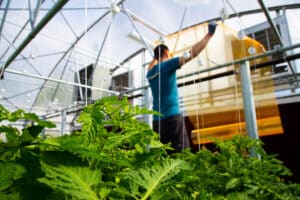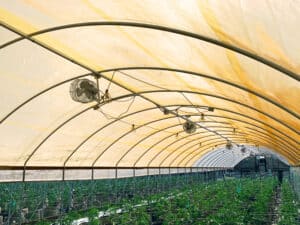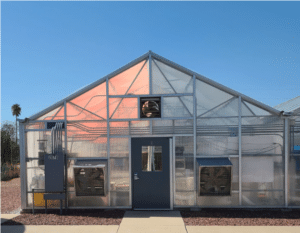
Electrochemical Gradients, Plant Metabolism, and Light Quality

In the realm of greenhouse cultivation, understanding the intricate processes governing plant metabolism, including the creation of electrochemical gradients and ATP generation, is not just a matter of scientific curiosity; it is a pivotal factor that can significantly impact crop yield and quality. If you ask a grower to describe photosynthesis, they might tell you it’s how plants use sunlight to grow.
However, few can explain how sunlight energy is transformed into chemical energy through the establishment of electrochemical gradients, ATP generation, and plant metabolism. This article describes the role of electrochemical gradients in photosynthesis, including electron transport and carbon fixation, as well as the impact of light quality on electron transport and ATP generation.
Beyond the familiar concept of photosynthesis lies a complex interplay of electrochemical gradients (EG), specifically proton motive force and ATP generation, that orchestrates crucial biochemical reactions within plant cells. Thus, this highlights the vital connection between light quality, electrochemical gradients, plant metabolism, and ATP generation. These factors in plant growth are crucial for optimizing greenhouse crop outcomes.
This article delves into the fascinating world of electrochemical gradients, unraveling their role in photosynthetic electron transport chains (PETC), the generation of ATP through proton motive force, and their influence on the activation of enzymes crucial for carbon fixation. As greenhouse growers aim to optimize conditions for plant growth, a comprehensive understanding of these processes becomes paramount.
Furthermore, this article explores the correlation between light quality and electron transport rate, shedding light on how manipulating the spectral composition of light can be a strategic tool for enhancing photosynthetic efficiency and the effect of light on plant growth. By examining the impact of light quality on electron transport chains, this discussion equips greenhouse cultivators with insights into maximizing crop productivity through informed adjustments in lighting strategies.

Electrochemical Gradients
An electrochemical gradient (EG) occurs when a chemical species, usually an ion, exists in different concentrations and charges on both sides of a membrane (a permeable boundary in an organism) (Figure 1).
Ions will move from an area of higher concentration to a lower concentration through passive diffusion. They also carry an electric charge, so their movement across membranes creates a transmembrane electrical potential. This results in a gradient that is not just chemical but electrochemical. Simply put, when an EG exists, the exterior and interior of a plant cell hold different electrical potentials, forming a transmembrane potential and changing the energy required to move across the membrane.

Photosynthetic Electron Transport Chains
Chlorophyll absorbs energy from sunlight and forms energy storage molecules (ATP and NADPH) in the light reactions of photosynthesis. Chlorophyll is present in thylakoid membranes, compartments inside chloroplasts (Figure 2). The electrochemical gradient (EG) that drives photosynthesis spans these thylakoid membranes and is modulated by photosynthetic electron transport chains (PETCs).
Electron transport chains (ETCs) consist of membrane-embedded proteins that easily accept or donate electrons. In photosystem II, energy received as light is transferred to a water molecule: the water molecule splits, yielding hydrogen ions, molecular oxygen, and a free electron to travel on the PETCs. The electron transport rate on the PETC, a critical factor in plant growth, is affected by light quality, described in the final section of this article.
As the PETC moves electrons in a specific direction across the thylakoid membrane, the electrical charges of the thylakoid interior (lumen) and exterior (stroma) shift. To balance this shift, protons (in the form of hydrogen ions) are pumped from the stroma into the lumen by the PETC molecules. In this manner, the PETC generates and maintains an electrically charged gradient across the thylakoid membrane, balanced by hydrogen protons and free electrons (Figure 3).

Proton Motive Force
When a plant receives light, electron/proton movement by the PETC results in a greater proton concentration in the lumen than in the stroma, generating an electrochemical gradient (EG). Proton motive force (PMF) is another name for EGs of protons. This PMF allows for another protein embedded in the thylakoid membrane, adenosine triphosphate synthase (ATP, ATPase), to produce chemical energy in the form of ATP. As the electron transport chain (ETC) shuttles more hydrogen protons into the lumen, the protons naturally want to diffuse back toward their lower concentration.
As they do, their movement physically rotates ATPase, converting potential energy into kinetic energy and combining adenosine diphosphate with inorganic phosphorus, yielding ATP (Figure 4). ATP is used for immediate energy needs or is turned into glucose for longer-term storage.

This proton movement not only facilitates ATP production, but also changes pH. When the plant receives light, the PETC moves protons into the lumen, making the lumen environment more acidic. To mitigate the electric potential across the thylakoid membrane, magnesium cations diffuse across the membrane from the lumen into the stroma.
This affects the activity of ribulose-1,5-bisphosphate carboxylase/oxygenase (RuBisCO), an enzyme in the stroma that is responsible for carbon fixation. RuBisCO exists in a deactivated and activated state; when activated, it acts as a catalyst. The increase in pH and magnesium, resulting from hydrogen efflux and magnesium influx, creates a more preferable environment for RuBisCO activation. In this manner, the PETC not only regulates ATP synthesis, but also plays a role in carbon fixation.
Respiratory ETCs
Photosynthesis is not the only metabolic process driven by the proton motive force. Proton gradients, also known as electrochemical gradients, are found in mitochondria, which break down glucose in respiration. In contrast with the PETC, the respiratory electron transport chain (RETC) and ATPase are embedded in the inner mitochondrial membrane.
The RETC does not receive free electrons from hydrolysis but rather from nicotinamide/flavin adenine dinucleotides (NADH/FADH2) (Figure 5). The RETC shuttles protons from the mitochondrial matrix into the intermembrane space to compensate for electron movement. The result is that carbohydrates produced through photosynthesis—which is significantly influenced by the effect of light on plant growth—can later be broken down for energy as needed.
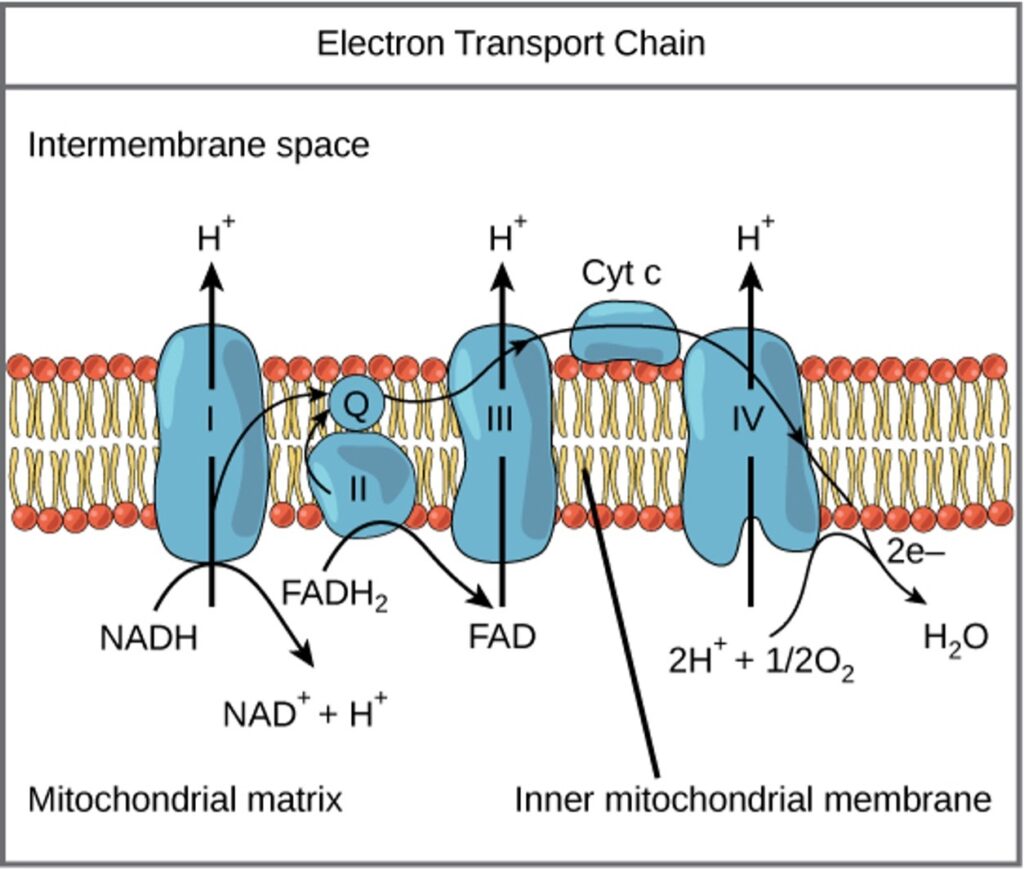
Light Quality and Electron Transport Rate
Light quality refers to spectral wavelength composition: for example, an LED fixture might emit a light quality of 80% red (600-700 nm), 20% blue (400-500 nm). Plants demonstrate growth responses to light qualities in the range of plant biologically active radiation (BAR, 280-750 nm). BAR encompasses radiation that is ultraviolet (UV, 280-400 nm), photosynthetically active (PAR, 400-700 nm), and far-red (FR, 700-750 nm). PAR contributes directly to photosynthesis and is divided into wavelength ranges corresponding to visible colors: blue, green, and red (400-500, 500-600, 600-700 nm, respectively).
These three colors exhibit different quantum yields (QY), the amount of CO2 or O2 evolved per light unit received. Red light provides the greatest quantum yield of all PAR colors and is considered the most photosynthetically efficient.
The effect of light on plant growth is profound, as red light is immediately directed to chloroplasts for photosynthetic processing; meanwhile, higher-energy PAR wavelengths (i.e., blue) are processed by accessory pigments (including carotenoids) to lose some energy before that energy is transferred to chloroplasts. High QY of red light has led to the development of photoconversion technologies that convert higher-energy BAR to red wavelengths (i.e., UV and blue to red). As a result, plant growth rates and yields increase.
Light quality changes QY by affecting photochemical efficiency (PE) and electron transport rate (ETR) on the PETC, amongst other variables. PE describes the amount of PAR that is photosynthesized versus dissipated as heat and is optimized when photosystems II and I (PSII, PSI) excitation states are balanced. The balance of excitation states can create an electrochemical gradient critical for ATP synthesis in plants. However, the photosystems have different peak absorption wavelengths, meaning the incident light quality impacts the balance between their excitation state.
Shorter PAR wavelengths (400-670 nm) typically excite PSII. Meanwhile, FR light (700-800 nm) preferentially excites PSI. When the functioning of both photosystems is balanced, ETR is optimized, leading to increased photochemical efficiency. This balance is a key factor in plant growth, and studying light quality effects on plant growth should consider individual wavelength intensities separately and ratios of wavelengths (e.g., R).

Electron transport chains move electrons and hydrogen protons, establishing an electrochemical gradient necessary for photosynthesis and respiration. The proton electrochemical gradient generates a proton motive force and regulates pH, facilitating ATP generation and RuBisCO activation. Light quality impacts the rate of electron transport on ETCs by affecting PSII and PSI activity.
In conclusion, exploring the intricate relationship between electrochemical gradients, plant metabolism, and light quality gives greenhouse growers a profound understanding of the underlying mechanisms governing photosynthesis. The electrochemical gradients, precisely proton motive force, play a central role in orchestrating vital biochemical reactions within plant cells that influence ATP generation and carbon fixation in plant metabolism.
The article illuminates the connection between light quality, electrochemical gradients, and electron transport rate, revealing how manipulating the spectral composition of light can be a strategic tool for optimizing photosynthetic efficiency in terms of ATP generation. As growers strive to enhance crop yield and quality in greenhouse cultivation, the insights presented here offer valuable knowledge for making informed decisions on adjusting lighting strategies to support plant metabolism, considering the factors in plant growth.
Therefore, technologies that manipulate light quality must consider light wavelength ratios that equally excite both photosystems and increase net photosynthesis. By recognizing the significance of electrochemical gradients and their interaction with light quality and plant metabolism, greenhouse cultivators are empowered to maximize the productivity of their crops through thoughtful and targeted environmental management, focusing on ATP generation within the context of plant metabolism.
References
Duysens, L. N. M., & Amesz, J. (1962). Function and identification of two photochemical systems in photosynthesis. Biochimica et Biophysica Acta, 64(2), 243-260.
Evans, J. R. (1987). The dependence of quantum yield on wavelength and growth irradiance. Functional Plant Biology, 14(1), 69-79.
Evans, J. R., Morgan, P. B., & von Caemmerer, S. (2017). Light quality affects chloroplast electron transport rates estimated from Chl fluorescence measurements. Plant and Cell Physiology, 58(10), 1652-1660.
Hogewoning, S. W., Wientjes, E., Douwstra, P., Trouwborst, G., Van Ieperen, W., Croce, R., & Harbinson, J. (2012). Photosynthetic quantum yield dynamics: from photosystems to leaves. The plant cell, 24(5), 1921-1935.
McCree, K. J. (1971). The action spectrum, absorptance and quantum yield of photosynthesis in crop plants. Agricultural Meteorology, 9, 191-216.
Myers, J. (1971). Enhancement studies in photosynthesis. Annual Review of Plant Physiology, 22(1), 289-312.
Su, J. H., & Shen, Y. K. (2005). Influence of State-2 transition on the proton motive force across the thylakoid membrane in spinach chloroplasts. Photosynthesis research, 85, 235-245.
Zhen, S., & van Iersel, M. W. (2017). Far-red light is needed for efficient photochemistry and photosynthesis. Journal of plant physiology, 209, 115-122.

Jeff Bates is Plant Biologist at UbiQD, Inc. With professional experience in both crop research and production, he has grown edible, ornamental, and medicinal crops using soilless cultivation methods in various controlled environment settings. These experiences have led him to believe that advancing controlled environment technologies is critical to supporting future generations.
Share:
Connect With Us
Company
Resources
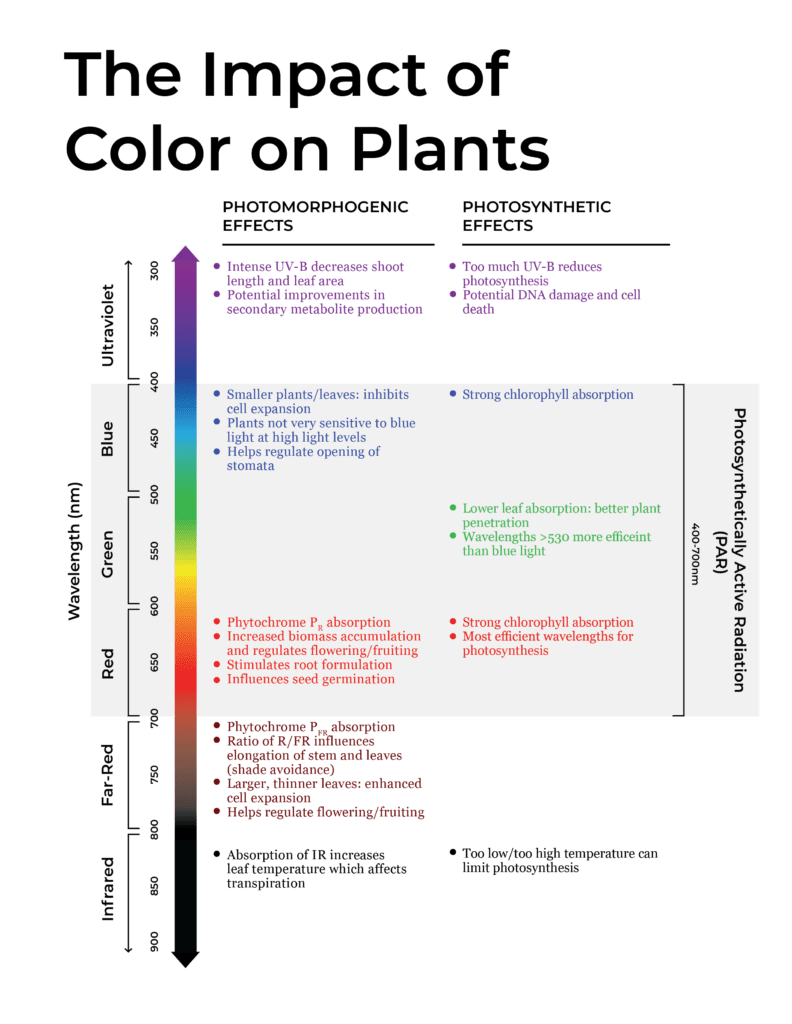

Hunter McDaniel, PhD
Founder & CEO
Hunter earned a Ph.D. in Materials Science and Engineering at the University of Illinois at Urbana-Champaign, before joining Los Alamos National Laboratory in the Chemistry Division. Ultimately the value proposition of UbiGro is about boosting crop yields and quality without the cost or energy impact of lighting. Hunter has more than fifty publications and patents, and more than 2000 total citations, h-index: 20. Hunter fundamentally believes that novel materials underpin every significant technology advancement, and he is focused on leveraging new materials to have a lasting and sustainable impact.

Damon Hebert, PhD
Director of Agriculture
Damon brings a wide range of experience in agriculture, materials science, spectroscopy, and small business. During his time in Prof. Angus Rockett’s research group at The University of Illinois at Urbana-Champaign (UIUC), Hebert authored a doctoral thesis and multiple papers on the materials science of CIGS semiconductor materials, which is closely related to the materials developed at UbiQD. He also served as a consultant to Nanosolar, a CIGS nanocrystal solar cell manufacturing company. Hebert has industry experience having co-founded Dr. Jolly’s, a leading cultivation and distribution operation in Bend, OR.

Tania Lafaille
Sales Representative
Tania is a UbiGro Sales Representative, with over 7 years of experience in product sales (specifically berries and avocados) covering all of North America and parts of South America. While in agriculture, Tania has cultivated strong relationships with growers and distributors, granting her a unique insight into both perspectives. That understanding, paired with her fierce dedication to results, drives her fun and fiery commitment to her craft. Tania is based in Gilroy, CA.

Tyler Veyna
Sales Representative
Tyler brings 15 years of experience in Greenhouse production and facility management of a wide range of crops in multiple states to the UbiGro team. Based in Salinas, California. “Being a fourth-generation farmer, I look to improve and empower the grower, and with UbiGro, we can do just that.”

Jim Gideon
Sales Manager
Jim Gideon is an UbiGro Sales Manager, with over 25 years of greenhouse industry sales experience covering all of North America. Previously Jim has worked for Green Tek, Plazit-Polygal, Texel, Cherry Creek, and Nexus. He is based in Montgomery, AL, and Jim believes that “light is everything to the grower.”

Eric Moody
Director of Sales
Eric Moody is UbiQD’s Director of UbiGro Sales. Eric has more than 6 years of experience in horticulture lighting industry, building relationships with greenhouse growers of all sizes and crops on optimal lighting for their growing operation, and most recently managed a North American sales team for PL Light Systems. Overall, Eric has been in sales leadership positions for more than 13 years. Eric brings with him a great understanding of the market and available technologies for growers, greenhouse facilities, and sales leadership. Reach Eric by phone at 541-490-6421 or by email at [email protected].

Mike Burrows, PhD
Dr. Michael Burrows is UbiQd’s Vice President of Business Development. His educational background includes a Materials Science doctorate from the University of Delaware and an MBA from Duke University Fuqua School of Business. His career has specialized in the commercialization of novel electronic materials in venture-run programs for different industries including solar, biosensors, and the automotive industry. In both start-up and corporate environments, he has extensive experience in global market development, foraging supply chain partnerships, productization, and brand building. He is currently leading UbiQD’s partnership efforts in luminescent greenhouse technology, smart windows, and security ventures.

Matt Bergern, PhD
Cheif Product Officer
As Chief Product Officer at UbiQD, Dr. Matt Bergren leads the company’s product development efforts, sales, and product manufacturing, including the company’s first commercial agriculture product, UbiGro. He plays a critical role in continuing the company’s path of technology development and vision of powering product innovations in agriculture, clean energy, and security.
He serves as the principal investigator for UbiQD’s contract with NASA, focused on tailoring the solar spectrum for enhanced crop production for space missions. Dr. Bergren’s leadership experience includes serving on the board of directors for the New Mexico Energy Manufacturing Institute, focused on job creation in New Mexico’s energy, and related manufacturing community.
